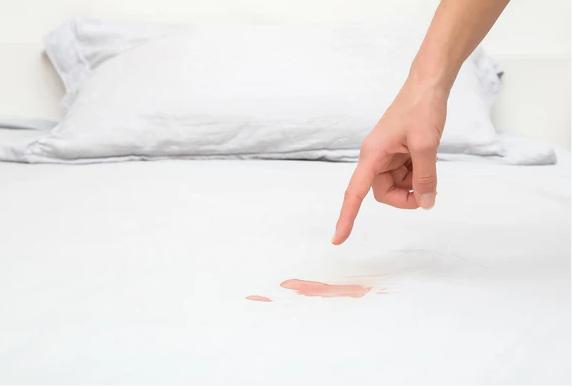Blood stains on bed sheets can be both an unwelcome sight and a tricky challenge. Whether resulting from a minor injury, a nosebleed, or an unexpected menstrual accident, blood stains can set quickly and become stubborn to remove if not treated promptly. Fortunately, with the right techniques and a bit of patience, you can effectively restore your sheets to their original, clean state.
In this guide, we’ll explore why blood stains are challenging to tackle, how to get blood stains out of bed sheets, and useful tips to prevent blood stains from setting to ensure your sheets remain spotless.

Why Blood Stains Are Difficult to Remove
Blood stains pose a unique challenge because of their biological composition. Blood contains proteins, specifically hemoglobin, which binds tightly to fabric fibers. When blood comes into contact with fabric, these proteins quickly set as they dry, making the stain difficult to remove. The coagulation of blood causes it to become more viscous and adhere firmly to fabric, which can complicate removal efforts.
Another factor complicating the removal of blood stains is the iron content within blood. Iron can act like a mordant, a substance that binds dyes to fabric. This property can cause blood to stain even more stubbornly, especially if heat is applied, which can permanently set the stain by effectively “cooking” it into the fabric. This makes cold water and prompt treatment crucial to preventing the stain from becoming permanent.
Effective Methods to Remove Blood Stains
Fortunately, several methods can be employed to remove blood stains from bed sheets effectively. Here are some tried-and-true techniques.
Cold Water Rinse
Cold water is your first line of defense against blood stains. Immediately rinse the stained area with running cold water. This helps to flush out as much of the blood as possible before it has a chance to set. The cold temperature prevents the proteins in the blood from bonding with the fabric fibers. Gently rub the fabric together under the running water to aid in loosening the stain. Avoid hot water, as it can set the stain permanently.
Hydrogen Peroxide Treatment
Hydrogen peroxide is a powerful cleaning agent due to its oxidizing properties, which break down proteins and lift stains. To use hydrogen peroxide, apply a small amount directly to the stain and allow it to bubble for a few minutes. The bubbling action helps to break down the blood proteins. Blot the area with a clean cloth, repeating the process until the stain begins to lighten. Once the stain is less visible, rinse thoroughly with cold water to remove any residue. Test a small, inconspicuous area first, as hydrogen peroxide can sometimes bleach fabrics.
Vinegar and Baking Soda Solution
A vinegar and baking soda solution is another effective method for blood stain removal. Mix equal parts vinegar and cold water, then apply the solution to the stain. Let it sit for about 10-15 minutes to penetrate the fibers. Afterward, blot the stain with a clean cloth to lift the vinegar solution. Next, sprinkle baking soda over the area and add a few drops of water to form a paste. Use a soft brush or cloth to gently scrub the paste into the fabric, allowing it to sit for a few minutes before rinsing thoroughly with cold water. This method leverages the acidity of vinegar and the mild abrasiveness of baking soda to effectively tackle stubborn stains.

Using Enzyme Cleaners
Enzyme cleaners are specifically designed to break down organic materials like blood proteins. These cleaners are particularly effective for treating blood stains that have dried or set. To use an enzyme cleaner, apply it to the stained area and let it sit for at least 15 minutes to allow the enzymes to work their magic. Gently scrub the area with a soft-bristled brush to help lift the stain. After treating the stain, wash the sheet in cold water to remove any remaining enzyme solution. Enzyme cleaners are widely available and can be found in most grocery stores or online.
Alternative Household Remedies
In addition to the methods mentioned above, several household items can be used to tackle blood stains:
– Lemon Juice: The acidity of lemon juice can help break down blood stains. Apply lemon juice directly to the stain, let it sit for 10 minutes, then rinse with cold water.
– Salt Paste: Make a paste using salt and water, then apply it to the stain. Allow it to sit for about an hour before rinsing. Salt acts as a gentle abrasive that can lift stains from fabric.
– Cornstarch: Mix cornstarch with cold water to form a paste and apply it to the stain. Let it dry completely, then brush off the residue. Rinse with cold water to remove any remaining paste.
Step-by-Step Cleaning Process to Remove Blood from Bed Sheets
Typically, you can follow this structured approach to maximize the effectiveness of blood stain removal.
Immediate Action for Fresh Stains
When dealing with fresh blood stains, act quickly to prevent the stain from setting. Remove the sheets and hold the stained area under cold running water as soon as possible. The goal is to rinse out as much blood as possible before it has a chance to dry. Gently blot the area with a clean cloth to avoid spreading the stain further.
Pre-Treating the Stain
For more stubborn stains, pre-treat the area with a stain remover or enzyme cleaner. Apply the product directly to the stain, and gently work it into the fabric using a soft brush or your fingers. Let the pre-treatment sit for 15-20 minutes to allow it to penetrate the stain and break down the proteins in the blood. This step is crucial for loosening the stain and making it easier to wash out.
Washing Techniques
After pre-treating the stain, wash the sheets in cold water using a heavy-duty laundry detergent. Set the washing machine to a regular or gentle cycle, depending on the fabric’s delicacy. Avoid using hot water or a dryer until you are certain the stain has been completely removed, as heat can set any remaining traces of blood into the fabric. If necessary, repeat the washing cycle to ensure the stain is thoroughly removed.
Drying and Final Inspection
After washing, carefully inspect the sheets for any remaining stains. If the stain remains, continue the pre-treatment and washing processes until the stain is completely eliminated. Once you are satisfied with the results, dry the sheets using the appropriate method for the fabric, such as air drying or tumble drying on a low setting. Avoid high heat settings, which can set stains if any remain.

Conclusion
So you know how to get blood out of bed sheets. Removing blood stains from bed sheets may seem daunting, but with the right techniques and a timely response, you can achieve spotless results. Utilizing both household and commercial cleaning agents can effectively tackle fresh and dried stains. By following the outlined methods and maintaining vigilance, you can preserve the cleanliness and longevity of your bed sheets.
FAQs
Can I use hot water to remove blood stains?
No, hot water should not be used to remove blood stains, as it can set the stain by causing the proteins in the blood to bind more tightly to the fabric fibers. Always use cold water to rinse and treat blood stains to prevent them from becoming permanent.
What natural products work best for blood stain removal?
Natural products such as vinegar, baking soda, hydrogen peroxide, and lemon juice are effective for blood stain removal. These products help break down proteins in the blood and can be used alone or in combination with each other to treat stains.
How do you get period blood stains out of bed sheets?
To remove period blood stains, act quickly by rinsing the stain with cold water. Pre-treat with an enzyme cleaner or a mixture of hydrogen peroxide and water. Wash the sheets in cold water with a heavy-duty detergent, and avoid using heat until the stain is fully removed.
